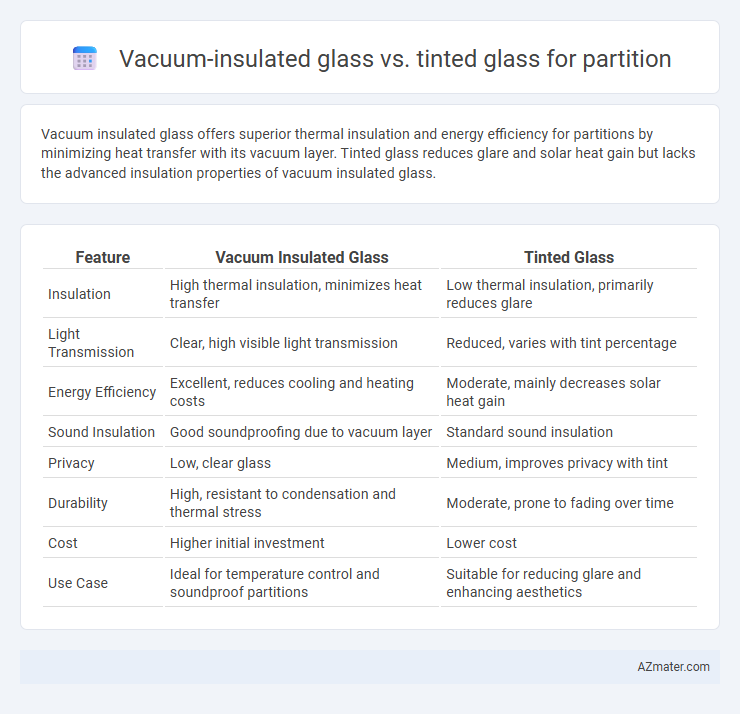Vacuum insulated glass offers superior thermal insulation and energy efficiency for partitions by minimizing heat transfer with its vacuum layer. Tinted glass reduces glare and solar heat gain but lacks the advanced insulation properties of vacuum insulated glass.
Table of Comparison
| Feature | Vacuum Insulated Glass | Tinted Glass |
|---|---|---|
| Insulation | High thermal insulation, minimizes heat transfer | Low thermal insulation, primarily reduces glare |
| Light Transmission | Clear, high visible light transmission | Reduced, varies with tint percentage |
| Energy Efficiency | Excellent, reduces cooling and heating costs | Moderate, mainly decreases solar heat gain |
| Sound Insulation | Good soundproofing due to vacuum layer | Standard sound insulation |
| Privacy | Low, clear glass | Medium, improves privacy with tint |
| Durability | High, resistant to condensation and thermal stress | Moderate, prone to fading over time |
| Cost | Higher initial investment | Lower cost |
| Use Case | Ideal for temperature control and soundproof partitions | Suitable for reducing glare and enhancing aesthetics |
Introduction to Glass Partitions
Vacuum insulated glass (VIG) offers superior thermal insulation and soundproofing qualities compared to traditional tinted glass, making it ideal for energy-efficient and quiet office partitions. Tinted glass primarily reduces glare and solar heat gain but lacks the advanced insulation properties of VIG. Choosing the right glass partition depends on balancing aesthetics, energy performance, and privacy needs within commercial or residential spaces.
What is Vacuum Insulated Glass?
Vacuum insulated glass (VIG) consists of two glass panes separated by a vacuum space, significantly reducing heat transfer and enhancing thermal insulation compared to traditional glass types. Unlike tinted glass, which primarily reduces glare and solar heat gain by adding color or coatings, vacuum insulated glass improves energy efficiency by minimizing conduction and convection. This makes VIG an ideal choice for partitions where both insulation and daylighting are essential.
Understanding Tinted Glass
Tinted glass for partitions effectively reduces solar heat gain and glare by incorporating metal oxides or other additives that absorb and reflect specific wavelengths of light, enhancing energy efficiency and occupant comfort. Unlike vacuum insulated glass, which primarily provides superior thermal insulation through a vacuum space between panes, tinted glass focuses on controlling visible and infrared light transmission to optimize natural lighting and privacy. Choosing tinted glass supports both aesthetic versatility and functional performance in partition designs, particularly in environments where light control and reduced cooling loads are priorities.
Thermal Performance Comparison
Vacuum insulated glass offers superior thermal performance for partitions by significantly reducing heat transfer due to its near-vacuum space between panes, achieving U-values as low as 0.2 W/m2K. Tinted glass primarily reduces solar heat gain by absorbing and reflecting infrared radiation but typically has higher U-values around 2.7 W/m2K, making it less effective in minimizing conductive heat loss. Consequently, vacuum insulated glass is better suited for energy-efficient partitions aiming to maintain stable interior temperatures and reduce HVAC costs.
Acoustic Insulation: Which Performs Better?
Vacuum insulated glass offers superior acoustic insulation compared to tinted glass due to its construction, which eliminates air gaps and significantly reduces sound transmission. Tinted glass primarily focuses on solar control and glare reduction, providing minimal noise reduction benefits. For partitions requiring enhanced soundproofing, vacuum insulated glass is the optimal choice due to its advanced noise dampening properties.
Energy Efficiency: VIG vs Tinted Glass
Vacuum insulated glass (VIG) offers superior energy efficiency compared to tinted glass by minimizing heat transfer through its vacuum layer, significantly reducing thermal conductivity and improving insulation. Tinted glass primarily lowers solar heat gain by absorbing or reflecting sunlight, which can reduce cooling loads but is less effective at preventing heat loss during colder months. VIG's advanced insulation properties make it an optimal choice for partitions requiring consistent energy savings across varying climates.
Aesthetic Versatility and Design Options
Vacuum insulated glass offers superior clarity and slim profiles, providing sleek, modern aesthetics ideal for minimalist partition designs. Tinted glass delivers a broad range of color options and privacy levels, enhancing mood and style through customizable shading and opacity. Both materials enable diverse design possibilities, but vacuum insulated glass excels in maintaining visual transparency while tinted glass emphasizes stylistic expression and light control.
Installation Process and Maintenance Needs
Vacuum insulated glass requires precise installation to maintain the vacuum seal, often demanding professional handling and specialized tools, while tinted glass installation follows conventional glazing methods with less complexity. Maintenance for vacuum insulated glass focuses on preserving the vacuum integrity by avoiding breakage or seal damage, resulting in minimal cleaning beyond standard glass care. Tinted glass requires routine cleaning to prevent dirt buildup that can obscure tint effectiveness and may need occasional replacement if the tint coating degrades over time.
Cost Analysis and Long-Term Value
Vacuum insulated glass offers superior thermal insulation, reducing energy costs over time, but its initial installation cost is significantly higher than tinted glass. Tinted glass, while more affordable upfront, provides limited energy efficiency and may result in increased heating and cooling expenses. Long-term value favors vacuum insulated glass for sustainable savings, whereas tinted glass suits budget-conscious projects with less emphasis on energy performance.
Choosing the Right Glass Partition for Your Space
Vacuum insulated glass offers superior thermal insulation, reducing energy costs and enhancing climate control in office or residential partitions. Tinted glass effectively minimizes glare and UV exposure, improving comfort while adding aesthetic appeal to spaces with high sunlight exposure. Selecting the right glass partition depends on factors such as energy efficiency requirements, natural light management, and design preferences.

Infographic: Vacuum insulated glass vs Tinted glass for Partition
 azmater.com
azmater.com